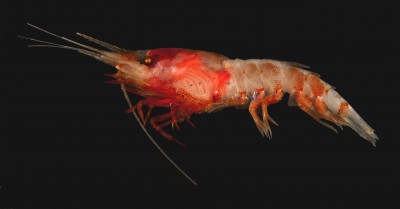NSU Newsroom
SharkBytes
Horizons
This version of NSU News has been archived as of February 28, 2019. To search through archived articles, visit nova.edu/search. To access the new version of NSU News, visit news.nova.edu.
This version of SharkBytes has been archived as of February 28, 2019. To search through archived articles, visit nova.edu/search. To access the new version of SharkBytes, visit sharkbytes.nova.edu.
Halmos College Researcher Receives Portion of National Science Foundation Grant to Study Deep-Sea Life
They are among the most unique looking animals in the oceans—deep-sea creatures. Seemingly out of the latest sci-fi movie from Hollywood, these animals rely on a trait that’s incredibly rare on land (i.e. fireflies) but very common in the oceans – bioluminescence.
While we know that many sea creatures can actually “light up” to hide their shadows, we have no idea how they’re able to so closely match the light around them with their own bioluminescence. That’s where Tamara Frank, Ph.D., a researcher at the Halmos College of Natural Sciences and Oceanography comes in.
Frank is joining Heather Bracken-Grissom at Florida International University and Megan Porter at the University of Hawaii in this research. Frank’s portion of the National Science Foundation grant is more than $215,000 over three years, while the total amount of the grant is $815,230.
What the research team will be focusing on is the evolution of bioluminescence and vision in deep-sea shrimp (Oplophoridae and Sergestidae), as well as how these primitive animals can so precisely control the intensity of their bioluminescence to match the down welling light.
“For most of us, natural light ceases around 700 meters down, but many of these deep-sea animals have truly magnificent eyes, so they can still see at depths humans can’t,” Frank said. “However, there is so much bioluminescence down there that it’s probably the major stimulus for the visual adaptations we’re seeing.”
Frank said that she will be accompanied by NSU graduate students on upcoming research trips to the Straits of Florida. So little is known about these creatures because it is so difficult to bring up live, healthy deep-sea animals, but Frank has a trawl net designed specifically for this purpose.
Her research will focus on the physiological control of this complex system. There have also been some major advancements in genomic techniques, allowing the other members of the team to study the co-evolution of vision and bioluminescence in these animals.
Frank also said that the research team will develop molecular and organismal-based curriculum and workshops, working with local schools to bring this research to life for elementary through college-age students.
This material is based upon work supported by the National Science Foundation under Grant No. DEB-1556279.”
